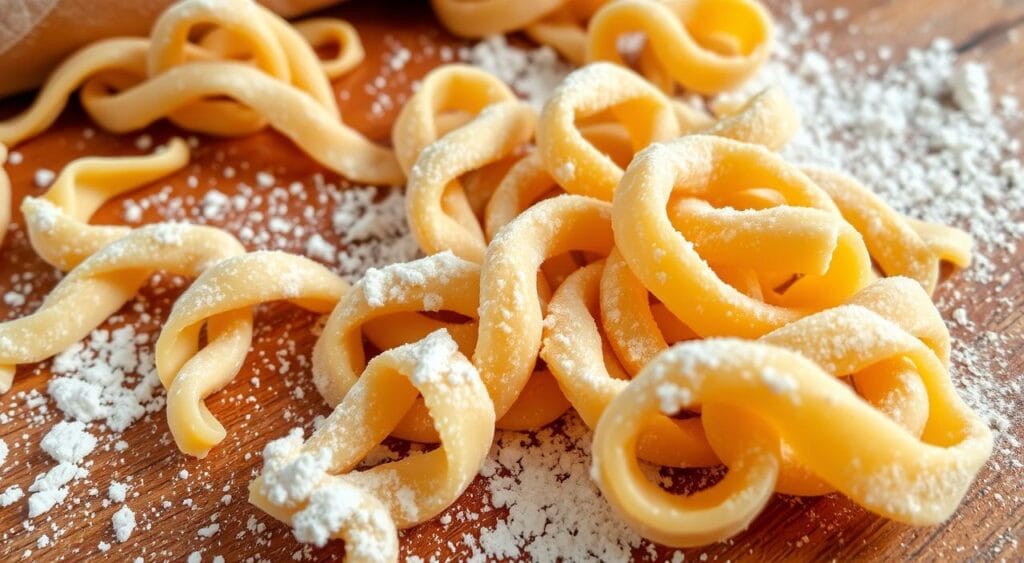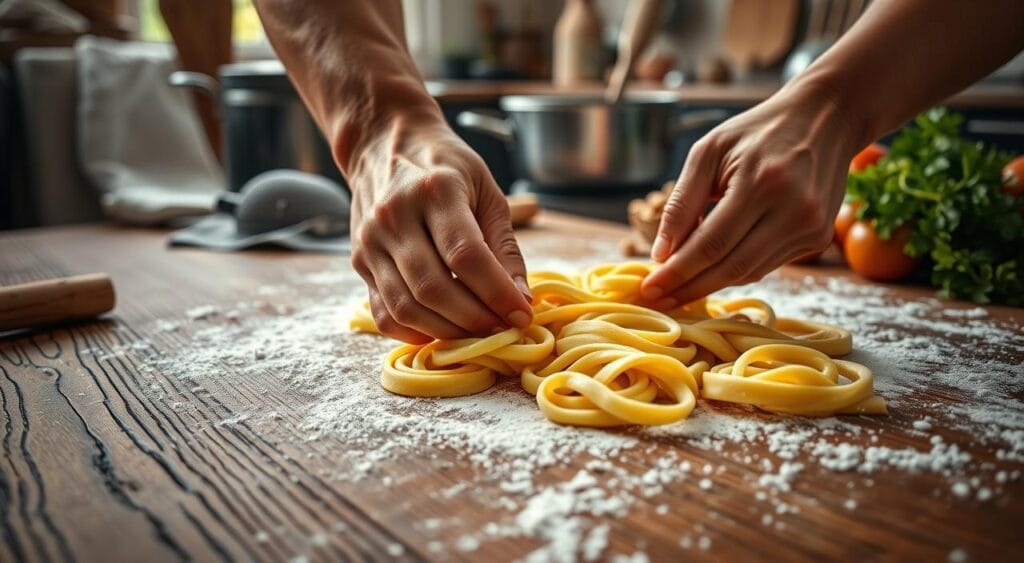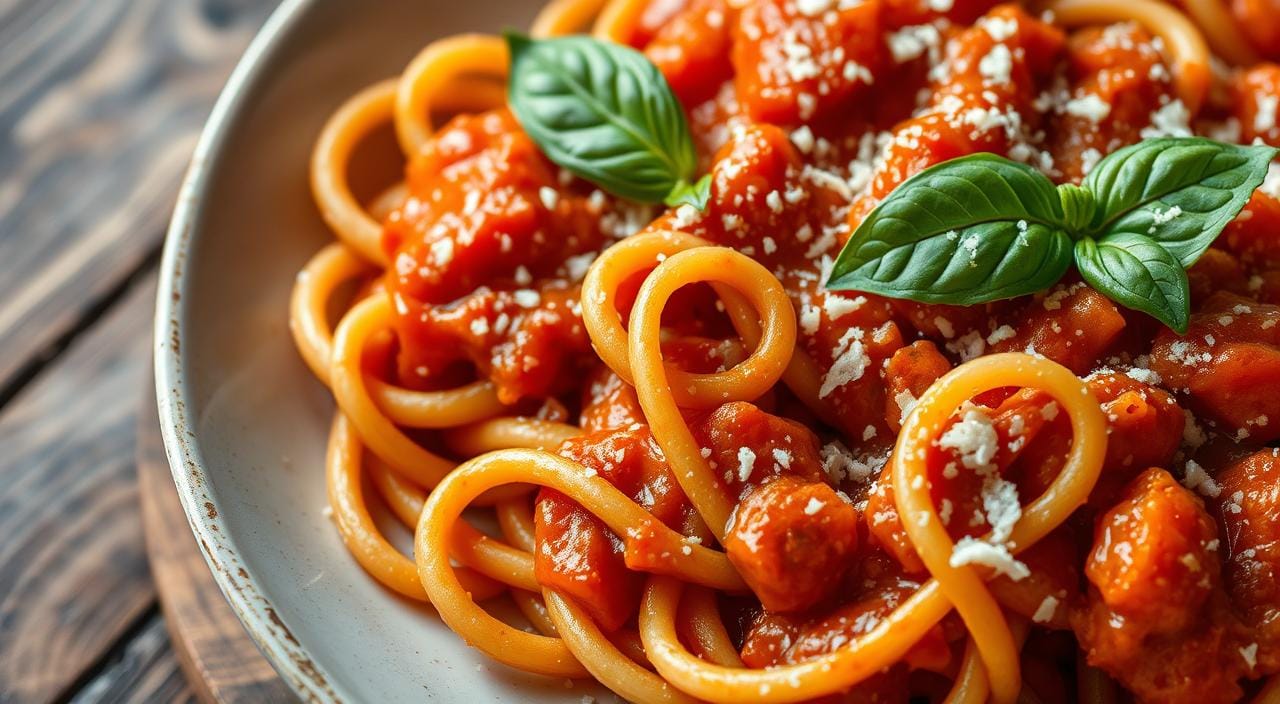Strozzapreti pasta has a fascinating story. It comes from the Emilia Romagna region in Italy. The name “strozzapreti” means “priest stranglers,” which is quite interesting.
The name comes from a time when the Papal States took over the area. The church took meat, milk, and eggs from farmers. To protest, farmer ladies made a pasta without eggs. They named it strozzapreti, hoping the priests would choke on it.
Today, strozzapreti is a symbol of the region’s history. It’s also a fun pasta for beginners to make at home.
Key Takeaways
- Strozzapreti pasta has a unique history tied to the priesthood in Italy.
- The name “strozzapreti” means “priest strangler” in Italian.
- Strozzapreti was created as a way for farmers to protest the church’s confiscation of their food supplies.
- Making strozzapreti pasta at home is a great way for novice cooks to try their hand at homemade pasta.
- Strozzapreti is a symbol of the Romagna region’s anarcho-socialist history.
Ingredients
Strozzapreti Pasta Dough
The base of tasty strozzapreti pasta is a simple dough. It’s made from just a few ingredients. Unlike many pasta, it doesn’t use eggs. Instead, it combines 00 flour, semolina flour, and water for the right texture.
To make the strozzapreti dough, you’ll need:
- 200g (2 cups) semolina flour or durum wheat flour
- 100ml (1/2 cup) warm water
- Pinch of salt
The dough’s simplicity comes from its history in Italy’s Emilia Romagna region. Farmers made pasta with flour and water because the church took their eggs. This method makes the pasta chewy and brings out the flour’s natural flavors.
“The simplicity of the dough is what makes strozzapreti so special. It’s a true testament to the power of quality ingredients and traditional techniques.”
After preparing the dough, you’re ready to shape the pasta. Roll out the dough and twist it into the unique, twisted shape. This shape gives the pasta its distinctive look and feel.

Instructions/Process/Steps
Making homemade pasta at home is a fun and tasty journey. To create the famous strozzapreti, a twisted pasta from Italy, follow these easy steps. They will guide you in shaping the pasta.
Step 1 – Preparing the Dough
Start by mixing 1 3/4 cups of all-purpose flour and 1 cup of finely ground semolina flour in a big bowl. Add 1/2 teaspoon of salt and mix it well. Then, add 1 cup of hot water slowly. Knead the dough for about 5 minutes until it’s smooth and elastic.
Cover the dough and let it rest for at least 30 minutes. This step is crucial before you start shaping the pasta.
Step 2 – Shaping the Strozzapreti
- Divide the rested dough into smaller pieces. Roll each piece into thin strips, like tagliatelle, with a thickness of about 1/3 of an inch.
- Take each strip and roll it between your palms to create the twisted shape of the strozzapreti.
- Pinch off 3-inch pieces of the twisted dough. Place them on a lightly floured surface to prevent sticking.
By following these simple steps, you can make traditional handmade pasta. Enjoy the unique texture and flavor of strozzapreti in your kitchen.

Serving and Storage Tips
Strozzapreti, the twisted pasta, is not just tasty but also easy to store and serve. These tips will help you enjoy your strozzapreti to the fullest, whether it’s for a meal or leftovers.
Tip 1 – Freezing Strozzapreti
Strozzapreti can be frozen for later use. Just place the shaped pasta on a baking tray and freeze until it’s firm. Then, move it to an airtight bag or container for up to a couple of months. This way, you always have pasta ready when you want it.
Tip 2 – Cooking Strozzapreti
To cook frozen strozzapreti, start by boiling a large pot of salted water. Add the frozen pasta and cook for about 2 minutes, until it’s al dente. Drain and toss with your favorite sauce or a simple olive oil and Parmesan topping.
Strozzapreti is a pasta that’s meant to be enjoyed. With these tips, you can make the most of it, whether it’s fresh or frozen. Learning how to store and cook strozzapreti will let you enjoy it again and again.
“Strozzapreti is a true treasure of Italian cuisine, with its captivating twists and ability to hold flavorful sauces. Mastering the storage and cooking techniques ensures you can savor this pasta’s unique qualities whenever the mood strikes.”
Benefits/Advantages
Making strozzapreti pasta at home brings many benefits. The dough, without eggs, has a chewy texture hard to find in store-bought pasta. This texture connects us to the culinary heritage of Emilia Romagna, showing the resourcefulness of local farmers.
Strozzapreti is also very versatile. It pairs well with many sauces and ingredients. This makes it a great addition to any home cook’s repertoire. Whether you’re making a classic Italian dish or trying new flavors, this pasta can take your cooking to the next level.
The act of making pasta is also rewarding. By making strozzapreti, you keep a part of culinary heritage alive. You also gain a deeper appreciation for handmade pasta. This connection to Italy’s traditions brings joy to the home cook.
“Homemade pasta is a treasure that connects us to the rich history and flavors of Italy.”
In today’s fast-paced world, homemade strozzapreti pasta offers more than just a meal. It shows the lasting value of homemade pasta benefits. It reminds us of the happiness found in traditional cooking.
Variations/Alternatives
There are different ways to shape strozzapreti besides rolling the dough between your palms. Some people use a thin rod or a barbecue skewer to get the twisted shape. Lidia Bastianich even made a gnocchi-like version of strozzapreti, showing how versatile it can be.
Strozzapreti can go with many sauces and ingredients. You can try them with roasted tomatoes, mushrooms, clams, or tomato sauce. This makes it easy to get creative and try out different pasta variations and regional specialties.
Acini de pepe look like tiny balls, similar to Israeli couscous, and are often in Italian wedding soup. Casarecce pasta has a loose shape, perfect for soaking up sauce. Gemelli are great for salads because of their double-helix shape.
Other pasta shapes include farfalle (bow ties), fettuccine, lasagna sheets, linguine, and rigatoni. These similar pasta shapes open up a world of creative pairings and culinary adventures.
“The diversity of pasta shapes and regional specialties in Italy is a testament to the rich culinary heritage and the ingenuity of Italian cooks.”
From the twisted strozzapreti to the delicate cavatelli and the classic spaghetti, pasta offers endless possibilities. It’s a vast and fascinating world, waiting to be explored and enjoyed.
Common Mistakes to Avoid
Making perfect strozzapreti, the twisted pasta, needs careful attention. The process might seem simple, but there are common mistakes to avoid. Here are some tips to help you make delicious strozzapreti every time.
The dough consistency is crucial. If the dough is too dry, the pasta might break when twisting. Too moist dough makes twisting hard, leading to uneven shapes. Finding the right balance is essential for avoiding breakage and getting a consistent shape.
Using the right pasta making tips is also key. Keeping your rolling and twisting even is vital for a uniform look and feel. If the twisting is uneven, your pasta will look messy, not beautiful.
“The key to perfect strozzapreti is finding the sweet spot between a dry and moist dough, and mastering the twisting motion to create a visually stunning and delicious pasta dish.”
Pay attention to the dough consistency and practice the twisting technique. This way, your strozzapreti will not only taste great but also look amazing. With a bit of practice, you’ll make strozzapreti that will impress everyone and satisfy your pasta cravings.
Helpful Notes
The history of strozzapreti, a beloved pasta from the Emilia Romagna region of Italy, is deeply rooted in the area’s social and political past. The name, which means “priest stranglers,” shows the local people’s anger towards the Papal States’ taxes and taking of resources. This history gives strozzapreti a special cultural meaning, showing the region’s fight for freedom.
Traditionally, strozzapreti is made by hand-rolling the dough. But today, cooks use tools like rods or skewers to shape it. This shows how the dish has stayed popular and flexible, even as it changes.
The dough for strozzapreti is made from flour, semolina, salt, and warm water. Kneading the dough for 4 to 5 minutes and letting it rest for 30 minutes to an hour is key. These steps help make the pasta just right.
Strozzapreti can be kept in the fridge or freezer. Freezing it means you can cook it straight from the freezer, adding just a minute or two to the cooking time. This is great for those who want to enjoy Italian food without the fuss of making it fresh.
“The connection between Strozzapreti pasta and priests dates back to the strong republican, anarchist, and socialist tradition of Romagna.”
Strozzapreti is often served with white sauce, olive oil, and Parmesan cheese. But it can also be paired with different sauces for each season. In summer, try it with zucchini and squash blossoms. In winter, a hearty sausage ragout is perfect. This makes strozzapreti a dish for any time of year.
Suggestions for Complementary Dishes
Monica Luppi, a seasoned expert on Emilia Romagna cuisine, suggests a unique pairing for strozzapreti pasta. She recommends a light, flavorful seafood sauce. It includes fresh tomatoes, succulent prawns, and a hint of basil and garlic.
This pairing highlights the pasta’s unique texture. It also complements the delicate sea flavors.
Additional Recommendations
Strozzapreti pasta is versatile and can be paired with many sauces. For a hearty option, try it with a wild boar ragù. Or, go for a creamy mushroom and roasted tomato sauce.
It also pairs well with meat-based sauces. Think sausage and broccolini ragu, or a classic clam and tomato sauce. Vegetarians can enjoy it with pesto or a vibrant roasted vegetable medley.
FAQ
What is the history behind the name “strozzapreti”?
The name “strozzapreti” means “priest stranglers” in Italian. It comes from the Emilia Romagna region of Italy. The local farmers named it this way because of their anger towards the Papal States’ taxes and taking of resources like meat, milk, and eggs.
What are the main ingredients in strozzapreti pasta?
Strozzapreti is made with 00 flour and water. It doesn’t have eggs. This is because the church took the farmers’ eggs, forcing them to use only flour and water to make pasta.
How is strozzapreti pasta shaped?
To shape strozzapreti, the dough is rolled between the palms to get the twisted shape. Some use a rod or skewer to help shape it. Lidia Bastianich also made a gnocchi-like version of strozzapreti.
How should strozzapreti be stored and cooked?
Strozzapreti can be frozen on a baking tray and then bagged. To cook, boil it in salted water for about 2 minutes. It should be al dente.
What are the benefits of making strozzapreti at home?
Making strozzapreti at home gives you a chewy texture that’s hard to find in store-bought pasta. It connects you to the culinary heritage of Emilia Romagna. It’s also versatile and can be paired with many sauces.
What are some common mistakes to avoid when making strozzapreti?
Avoid a dry dough to prevent the pasta from breaking. Too much moisture makes it hard to twist. Keep the dough consistent in moisture and technique for even shapes and textures.
What are some recommended sauce pairings for strozzapreti?
Monica Luppi suggests a seafood sauce with fresh tomatoes, prawns, basil, and garlic. Strozzapreti also goes well with roasted tomato and mushroom, clam and tomato, sausage and broccolini, or wild boar ragù.

